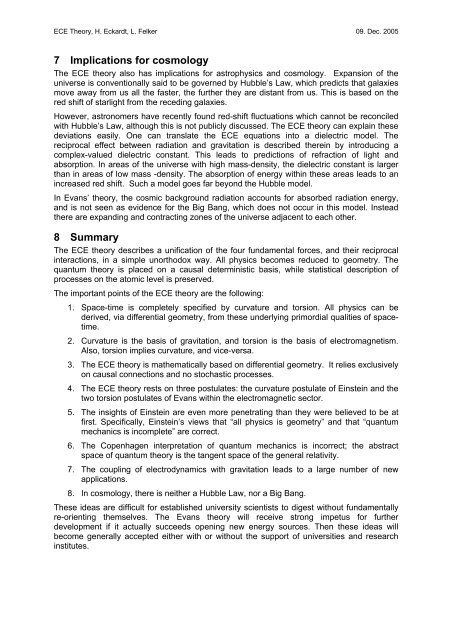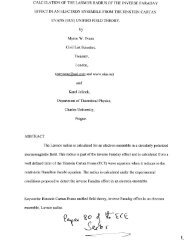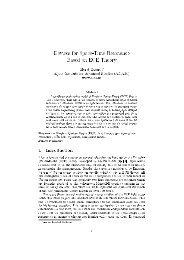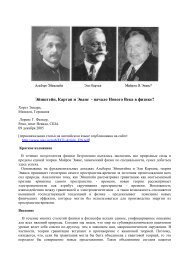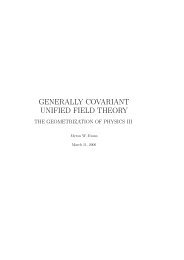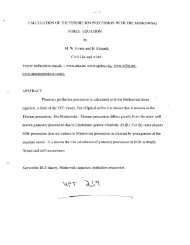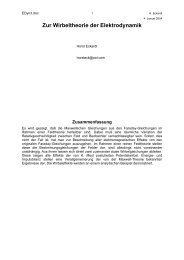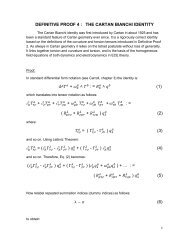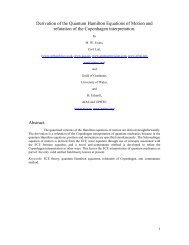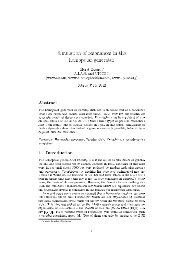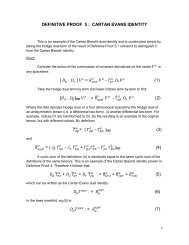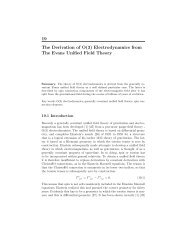Einstein, Cartan and Evans – Start of a New Age in Physics? - Aias.us
Einstein, Cartan and Evans – Start of a New Age in Physics? - Aias.us
Einstein, Cartan and Evans – Start of a New Age in Physics? - Aias.us
You also want an ePaper? Increase the reach of your titles
YUMPU automatically turns print PDFs into web optimized ePapers that Google loves.
ECE Theory, H. Eckardt, L. Felker 09. Dec. 2005<br />
7 Implications for cosmology<br />
The ECE theory also has implications for astrophysics <strong>and</strong> cosmology. Expansion <strong>of</strong> the<br />
universe is conventionally said to be governed by Hubble’s Law, which predicts that galaxies<br />
move away from <strong>us</strong> all the faster, the further they are distant from <strong>us</strong>. This is based on the<br />
red shift <strong>of</strong> starlight from the reced<strong>in</strong>g galaxies.<br />
However, astronomers have recently found red-shift fluctuations which cannot be reconciled<br />
with Hubble’s Law, although this is not publicly disc<strong>us</strong>sed. The ECE theory can expla<strong>in</strong> these<br />
deviations easily. One can translate the ECE equations <strong>in</strong>to a dielectric model. The<br />
reciprocal effect between radiation <strong>and</strong> gravitation is described there<strong>in</strong> by <strong>in</strong>troduc<strong>in</strong>g a<br />
complex-valued dielectric constant. This leads to predictions <strong>of</strong> refraction <strong>of</strong> light <strong>and</strong><br />
absorption. In areas <strong>of</strong> the universe with high mass-density, the dielectric constant is larger<br />
than <strong>in</strong> areas <strong>of</strong> low mass -density. The absorption <strong>of</strong> energy with<strong>in</strong> these areas leads to an<br />
<strong>in</strong>creased red shift. Such a model goes far beyond the Hubble model.<br />
In <strong>Evans</strong>’ theory, the cosmic background radiation accounts for absorbed radiation energy,<br />
<strong>and</strong> is not seen as evidence for the Big Bang, which does not occur <strong>in</strong> this model. Instead<br />
there are exp<strong>and</strong><strong>in</strong>g <strong>and</strong> contract<strong>in</strong>g zones <strong>of</strong> the universe adjacent to each other.<br />
8 Summary<br />
The ECE theory describes a unification <strong>of</strong> the four fundamental forces, <strong>and</strong> their reciprocal<br />
<strong>in</strong>teractions, <strong>in</strong> a simple unorthodox way. All physics becomes reduced to geometry. The<br />
quantum theory is placed on a ca<strong>us</strong>al determ<strong>in</strong>istic basis, while statistical description <strong>of</strong><br />
processes on the atomic level is preserved.<br />
The important po<strong>in</strong>ts <strong>of</strong> the ECE theory are the follow<strong>in</strong>g:<br />
1. Space-time is completely specified by curvature <strong>and</strong> torsion. All physics can be<br />
derived, via differential geometry, from these underly<strong>in</strong>g primordial qualities <strong>of</strong> spacetime.<br />
2. Curvature is the basis <strong>of</strong> gravitation, <strong>and</strong> torsion is the basis <strong>of</strong> electromagnetism.<br />
Also, torsion implies curvature, <strong>and</strong> vice-versa.<br />
3. The ECE theory is mathematically based on differential geometry. It relies excl<strong>us</strong>ively<br />
on ca<strong>us</strong>al connections <strong>and</strong> no stochastic processes.<br />
4. The ECE theory rests on three postulates: the curvature postulate <strong>of</strong> <strong>E<strong>in</strong>ste<strong>in</strong></strong> <strong>and</strong> the<br />
two torsion postulates <strong>of</strong> <strong>Evans</strong> with<strong>in</strong> the electromagnetic sector.<br />
5. The <strong>in</strong>sights <strong>of</strong> <strong>E<strong>in</strong>ste<strong>in</strong></strong> are even more penetrat<strong>in</strong>g than they were believed to be at<br />
first. Specifically, <strong>E<strong>in</strong>ste<strong>in</strong></strong>’s views that “all physics is geometry” <strong>and</strong> that “quantum<br />
mechanics is <strong>in</strong>complete” are correct.<br />
6. The Copenhagen <strong>in</strong>terpretation <strong>of</strong> quantum mechanics is <strong>in</strong>correct; the abstract<br />
space <strong>of</strong> quantum theory is the tangent space <strong>of</strong> the general relativity.<br />
7. The coupl<strong>in</strong>g <strong>of</strong> electrodynamics with gravitation leads to a large number <strong>of</strong> new<br />
applications.<br />
8. In cosmology, there is neither a Hubble Law, nor a Big Bang.<br />
These ideas are difficult for established university scientists to digest without fundamentally<br />
re-orient<strong>in</strong>g themselves. The <strong>Evans</strong> theory will receive strong impet<strong>us</strong> for further<br />
development if it actually succeeds open<strong>in</strong>g new energy sources. Then these ideas will<br />
become generally accepted either with or without the support <strong>of</strong> universities <strong>and</strong> research<br />
<strong>in</strong>stitutes.


